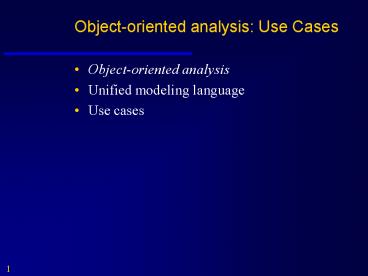Objectoriented analysis: Use Cases - PowerPoint PPT Presentation
1 / 27
Title:
Objectoriented analysis: Use Cases
Description:
A way to describe a model of the application. A comprehensive methodology that ... The Unified Modeling Language tries to integrate older approaches ... – PowerPoint PPT presentation
Number of Views:49
Avg rating:3.0/5.0
Title: Objectoriented analysis: Use Cases
1
Object-oriented analysis Use Cases
- Object-oriented analysis
- Unified modeling language
- Use cases
2
Why is OO popular?
- The hope that it will increase productivity
- Natural way of structuring the world
- Objects
- Messages
- Responsibility
3
What is object-oriented software development?
- A way to view the world of the application
- A way to describe a model of the application
- A comprehensive methodology that
- allows to develop a software system
- uses similar concepts within the whole
development process
4
Object oriented system development
- Means to achieve high quality
- Information Hiding
- Abstraction
- Modularization
- Reuse
- An object oriented approach - more or less -
forces the software developer to apply these
concepts
5
Abstract data type
- object data structure behavior tight
coupling - abstract data type class of data structures
available services
6
Object-oriented analysis Use Cases
- Object-oriented analysis
- Unified modeling language
- Use cases
7
OO methodologies
- Late 80s early 90 several OO methodologies
developed - different notations
- different processes
- Main approaches
- Booch
- Rumbaugh
- Jacobsen
8
UML
- The Unified Modeling Language tries to integrate
older approaches - Developed by Rational (CASE tool)
- they hired Booch, Rumbaugh, Jacobsen
- Standardized by the OMG (Object management group)
- Supported by all OO CASE tools
9
Notations and meta-models
- Notation Graphical syntax of the modeling
language - Meta-model A model that defines a modeling
language
10
UML notation
- Use case diagrams
- Class object diagrams
- Sequence collaboration diagrams
- State activity diagrams
- Implementations diagrams
- Package, deployment diagrams
11
Use case diagrams
- Requirements/ early analysis
Market Analysis
Financial Planner
12
Class diagrams
Actuator
startUp( )
shutDown( )
Light
Heater
Cooler
Temperature
1
1
1
1
off( )
on( )
1
1
1
1
1
1
Environmental Controller
SystemLog
Define_climate( )
Display( )
Terminate_climate( )
RecordEvent( )
13
Sequence diagrams
Temperature Controller
Air Conditioner
SystemLog
Environmental Controller
Cooler
1 RecordEvent ( )
2 startUp ( )
3 RecordEvent ( )
14
Collaboration diagrams
2 startUp ( )
Temperature Controller Environmental Controller
Air Conditioner Cooler
1 RecordEvent ( )
3 RecordEvent ( )
SystemLog
15
State diagrams
Initialize
Temperature drop or rise / adjustTemperature()
Idle
Define Climate
Daytime
Terminate Climate
Sunset / Lightsoff()
Temperature drop or rise / adjustTemperature()
Terminate Climate
Sunrise / Lightson()
Nighttime
16
Package diagrams
Automated
Gardener
GUI Library
Planning
Gardening
Database
Greenhouse
Climate
Nutrients
17
Object-oriented analysis Use Cases
- Object-oriented analysis
- Unified modeling language
- Use cases
18
What is a use case?
- Typical interaction between actors and system
- Process that satisfies a users need
- Describes a scenario how the system is used
- Example Word processor
- Make some text bold
- Create an index
- Delete a word
19
Properties of use cases
- Granularity Small or large
- Achieve a discrete goal
- Use cases describe externally required
functionality - Often Capture user-visible function
20
When and how
- Requirements capture - first thing to do
- Use case Every discrete thing your customer
wants to do with the system - give it a name
- describe it shortly (some paragraphs)
- add details later
21
Use case diagram
ltltusesgtgt
Valuation
Analyze risks
ltltusesgt
Trader
Price details
Sales system
Capture deal
ltltextendsgtgt
Limit exceeded
22
Actors
- Role that a user plays with respect to the system
- Actors carry out use cases
- look for actors, then their use cases
- Actors do not need to be humans!
- Actors can get value from the use case or
participate in it
23
Extends relationship
- Extends One use case is similar to another but
does a bit more - Capture the simple, normal use case first
- For every step ask
- what could go wrong
- how might this work out differently
- Plot every variation as an extension of the use
case
Capture deal
ltltextendsgtgt
Limit exceeded
24
Uses relationship
- Used when a chunk of behavior is similar across
more than one use case - Avoids copy-and-paste of parts of use case
descriptions
25
Comparing extends/uses
- Different intent
- extends
- same actor performs use case and all extensions
- actor is linked to base case
- uses
- often no actor associated with the common use
case - different actors for caller cases possible
26
Use case description
- Generic, step-by-step written description of the
interactions between the actor(s) and a use case - Clear, precise, short descriptions
27
Example use case description
- Normal sequence Capture deal
- 1. Enter the user name bank account
- 2. Check that they are valid
- 3. Enter number of shares to buy share ID
- 4. Determine price
- 5. Check limit
- 6. Send order to NYSE
- 7. Store confirmation number
- Describe alternative sequences































